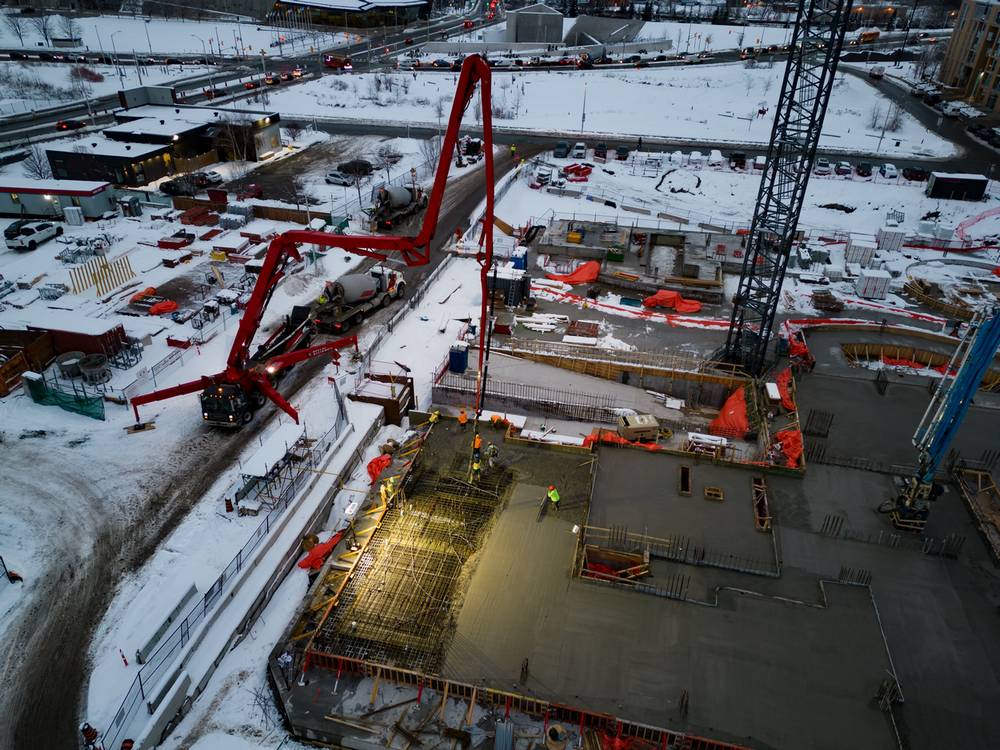
By Kevin Bright
Implementing sustainable practices on the jobsite is critical for a greener future. These methods reduce environmental impact, conserve resources and promote long-term economic viability. Incorporating eco-friendly materials, efficient energy usage and responsible waste management can contribute to a healthier planet, while saving long-term costs and meeting growing infrastructure needs. In addition to an efficient design that incorporates renewable energy, LED lighting and smart HVAC systems, the following are three top energy conservation strategies that superintendents can utilize on the jobsite.
1. Work sequencing opportunities due to weather
When constructing a building in colder climates, wintertime can pose several challenges for a construction project. Typically, projects use temporary plastic sheets to cover windows and door openings that keep some heat inside the building to ensure materials, such as concrete, cure completely and aren’t damaged by the colder temperatures. These heating systems can run anywhere from $12,000-20,000 per month during the construction project.
Identifying other ways to reduce the amount of heat needed to maintain safe indoor temperatures during construction can help lower utility costs and limit fuel emissions. Recommended approaches you can employ to help effect the amount of temporary heating fuel needed on your jobsite during the winter months include:
- Use of reusable temporary enclosures. Instead of using plastic, for some projects you can use reusable temporary enclosures with a higher insulating value to enclose indoor spaces. The insulative value of the temporary wall is much higher compared to the plastic coverings, which reduce fuel consumption throughout the winter months. As floors are prepared, you can move the temporary enclosures, then follow the scheduled construction work as it progresses.
- Keep the building weather tight. Design teams can identify alternative construction approaches to make the building weather tight throughout the winter months. In some cases, this means you must reprioritize work so that some exterior detail work is left for warmer temperatures in the spring. Having the building completely weather tight before wintertime temperatures provides many advantages and significantly reduces the amount of heating to be roughly equivalent to the building when in full operation.
- Limit work in partially enclosed indoor spaces. Provide opportunities to review a project’s schedule and work with subcontractors to identify alternative approaches. Reducing the amount of work in partially enclosed interior spaces can offer significant savings both financially and environmentally.
2. Material reuse opportunities
During the construction of a building, a lot of materials are used on a temporary basis to meet safety requirements or to prepare a site for concrete pours. The materials are often used once and then discarded. However, by identifying ways that these materials can be reused throughout the construction process will limit waste and provide cost savings.
One way is through lumber reuse. When constructing a tower, safety railings and platform systems are needed throughout construction to keep your crew safe from falls. The systems follow the building’s construction as floors are being added to the building’s height. This provides an opportunity to think creatively about material reuse.
For example, in one of our tower projects, temporary lumber was reused multiple times throughout the building’s construction for its safety railing and tie-off system. As the building’s floors were added, the safety system was deconstructed and rebuilt for the next floor up. In this case, the temporary lumber for the safety systems was reused two to three times and then repurposed as blocking in the building’s final construction. This afforded an extended life for the material itself, reduced waste and trailer pickups and limited the need for additional lumber on the project, saving costs and natural resources.
3. Implement methods to reduce construction waste
With the adoption of LEED and other green building rating systems, reusing, recycling or diverting waste from the landfill have grown in adoption. Projects around the region are identifying ways to minimize waste to provide cost savings and additional environmental benefits.
As recyclable material is designated into dumpsters, source separating onsite is the best way to reduce landfill contributions. Typically, dumpsters for wood, gypsum and metals are present at different periods of a project’s construction. This separation typically enhances a project’s overall diversion rate to around 90%, as more material can be recovered for recycling. However, source separation can be difficult for sites without a lot of space. A second option is a commingled recycling route with some waste partners. These facilities collect the dumpsters and separate them at their yard. These operations are typically able to recycle around 80% of the waste by weight over the course of a project.
Finally, training your team on energy-saving practices will encourage responsible energy usage. For example, tracking energy consumption by optimizing machinery and equipment usage, scheduling and transport logistics and regularly assessing a project’s environmental impact can identify areas of improvement.
Embracing energy-conserving practices on the jobsite is not just a responsible choice but a necessity. It safeguards the environment, cuts operational costs and aligns with global sustainability goals. When you prioritize energy efficiency, it’s a win-win, ensuring a brighter, more sustainable future for generations to come.
Kevin Bright is sustainability manager at Kraus-Anderson Construction.
Photo by Braeson Holland


 Join our thriving community of 70,000+ superintendents and trade professionals on LinkedIn!
Join our thriving community of 70,000+ superintendents and trade professionals on LinkedIn! Search our job board for your next opportunity, or post an opening within your company.
Search our job board for your next opportunity, or post an opening within your company. Subscribe to our monthly
Construction Superintendent eNewsletter and stay current.
Subscribe to our monthly
Construction Superintendent eNewsletter and stay current.